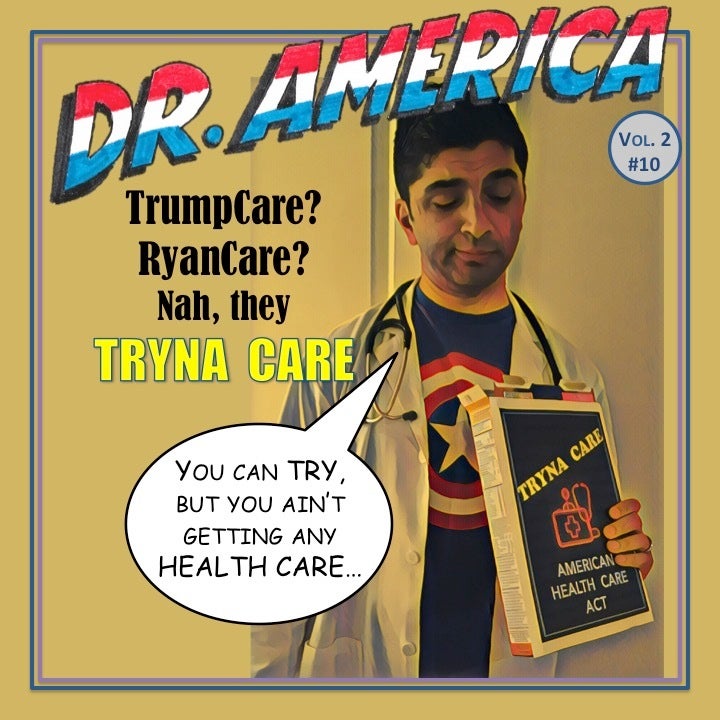
#Trumpcare? #Ryancare? More like #TrynaCare -- America can try, but we ain't gettin no care with #AHCA. Hear more on the NEW EPISODE of Dr America
March 2017 started with House Republicans using secret rooms in the Capitol to hide rough drafts of bills to repeal and replace the Affordable Care Act. No really, Republican members of Congress had Capitol Police standing outside a room containing the legislation. Then that legislation went missing, and there was a ridiculous wild goose chase to find the bills. Those antics ended last week when Speaker Paul Ryan and House Republicans presented the American Health Care Act. Now the Congressional Budget Office (CBO) is confirming the assessments of health care providers, hospitals, and senior citizens: the AHCA will wreck healthcare and leave 24 million more Americans without coverage.
There are squabbles over whether to nickname the AHCA TrumpCare or RyanCare. I’m calling it TrynaCare: you can try, but you ain’t getting no health care. Here are the reasons why this bill needs to be permanently locked away in whatever secret room stores terrible ideas.
1. TrumpCare/RyanCare wrecks Medicaid
Currently, over 70 million Americans are on Medicaid, including 33 million children, 10 million seniors, and 6 million Americans with disabilities. Despite its lean budget, Medicaid is delivering excellent care that patients rate higher than the private insurance industry. In Washington, DC and the 31 states that opted to expand Medicaid under the Affordable Care Act, 15 million adults with low incomes are covered and reporting high satisfaction.
Under the American Health Care Act, expansion of Medicaid is allowed until the year 2020. Then, the bill requires states to freeze enrollment of new people and the open-ended commitment of federal funding stops. AHCA slashes $880 billion from Medicaid by changing its funding to per person caps, where each state gets a small lump sum of federal money per enrollee in its Medicaid program. The per person cap approach to funding drastically reduces support for Medicaid patients. To run Medicaid under such tight restraints, states will change the rules on who is eligible for the program and kick people off. The CBO reports these drastic changes to Medicaid result in 14 million more people losing coverage, over half of the 24 million more uninsured because of TrumpCare/RyanCare. Patients who can stay on capped Medicaid will see reduced benefits because states will not be able to afford as many services like dental care, physical therapy, treatment for substance abuse, and so on.
By implementing an enrollment freeze and per person caps in 2020, House Republicans ignore the fact that patients and families go on and off Medicaid because their circumstances change. A family may leave Medicaid because a mother finally got a job with health insurance benefits, but then she loses the job when the company transfers somewhere the family can not go. Or maybe a family’s housing situation changes because of a natural disaster. Women who leave abusive partners often qualify for Medicaid for a few years as they get back on their feet. Medicaid is there for all of these struggles, helping families get health care without costing them more peace of mind. Cycling in and out of the program is administratively complicated, but it is part of how Medicaid maintains a lifeline of dignity. TrumpCare/RyanCare’s per person caps ruin Medicaid’s ability to be a nimble first responder to large and small crises for families and communities.
2. TrumpCare/RyanCare is stingy with support for patients, even when premiums skyrocket.
Currently, the ACA helps people pay for health insurance premiums through income-based subsidies: the lower your income, the more help you get. TrumpCare/RyanCare plans to give very limited support using tax credits based on age. To understand how devastating this is for low-income older patients (who tend to have more health care needs), consider the Congressional Budget Office’s example of two people, ages 40 years old and 64 years old, both making the same barely-above-poverty income of $26,500 a year. Under the ACA, most of the premiums are covered by subsidies and both people pay about $1,700 a year. Under TrumpCare/RyanCare, the 40 year old gets a tax credit but still pays $700 more a year to cover premiums. The 64 year old gets a slightly larger tax credit because of her age, but still pays nearly $13,000 more a year for premiums.
The older patient is getting less help, and has to pay more for insurance under TrumpCare/RyanCare because the insurance companies are allowed to age-discriminate, charging older patients 5 times higher premiums than younger patients. To make matters worse, the bill has no financial assistance to help people with low incomes pay for deductibles and co-pays. That 64 year old just spent about half her income in premiums, but will continue to pay out-of-pocket for health care.
3. TrumpCare/RyanCare puts insurance industry profits before patients.
Like the Affordable Care Act, TrumpCare/RyanCare also bans insurance companies from denying coverage to people with pre-existing conditions. However, the ACHA bill has a catch: Patients with pre-existing conditions must maintain “continuous coverage.” If for whatever reason a patient does not have insurance for 63 days or more, then TrumpCare/RyanCare allows insurance companies to charge that patient a 30 percent surcharge on their premiums for one year. After that year the premiums will go back to the “standard rate.”
Working and middle class Americans know from experience that maintaining “continuous coverage” is incredibly challenging. Lapses in insurance coverage happen for all kinds of normal everyday reasons: time between jobs becomes longer than people think; housing situations change; or people get sick. My colleagues caring for cancer patients see it all the time: 85 percent of cancer patients stop working for 45 days to 6 months while getting treatment. During that time they can lose their job, lose health insurance, and before you know it, there’s a lapse in coverage. TrumpCare/RyanCare allows insurance companies to charge these patients 30 percent more on their premiums. It’s hard enough to fight cancer but now our friends and families will have to watch out for insurance companies just trying to catch them without coverage? Seriously?
Upcharging sick patients is not the only treat for the insurance industry in TrumpCare/RyanCare. Right now, the ACA limits insurance companies on how much executive pay they can claim in their tax deductions. An insurance company can only deduct $500,000 of each top executive’s pay from the company’s taxes. The ACA also closed a loophole lots of corporations use to deduct the cost of stock options and so-called performance-based pay. These limits are very specific to the insurance industry because the ACA figures executives can live with the money they make off of millions of new customers buying health insurance.
TrumpCare/RyanCare gets rid of all those rules on executive pay and taxes. The AHCA bill allows insurance companies to deduct $1 million for each executive’s pay and to deduct the cost of so-called “performance-based” stock awards and options. Speaker Paul Ryan wants insurance companies to enjoy the same tax code treats big Wall Street corporations have. As you might have guessed, the money adds up “bigly.” According to the Institute for Policy Studies, the 10 biggest insurance companies paid their top 57 executives a combined total of $300 million in 2013. The ACA allowed the companies to deduct 27 percent of that from taxes. With TrumpCare/RyanCare, the big insurance companies can deduct 96 percent of that executive pay from taxes. When all the tax breaks in TrumpCare/RyanCare are added up, insurance companies and the super-rich are getting nearly $600 billion.
If all this weren’t bad enough, TrumpCare/RyanCare wipes out Medicaid funding for Planned Parenthood and slashes the Medicare trust fund. To fight back, we must hold Trump accountable for breaking his promises. Since coming down his golden escalator in May 2015, Trump has talked about how he’d come up with “something terrific” to replace the ACA and there’d be “insurance for everybody.” To fight back, we must hold Speaker Paul Ryan and House Republicans accountable for taking more than 60 votes over the past 7 years to repeal the ACA with no replacement, then pushing this plan leaving 24 million more people without coverage. The majority of the American people did not vote for the Trump regime, and they absolutely did not vote for the demolition of American health care while giving away billions to the super-wealthy. To fight back, call 202-224-3121 to tell your House Representative and Senators (it does not matter what party they belong to because politicians who agree will be glad to hear you) to stop the American Health Care Act. TrumpCare/RyanCare is only TrynaCare for our health, and we deserve better.
To hear more about the dangers of TrumpCare/RyanCare, listen to the March 10 episode of Dr America.
Have you or your family benefited from the Affordable Care Act? If you’d like to share your story on HuffPost, email us at ACAstories@huffingtonpost.com.
